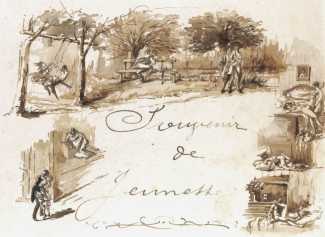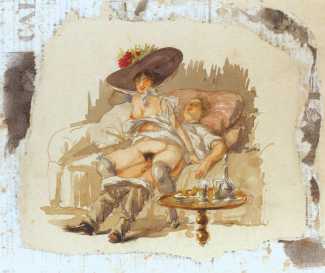 In June 2011 the prestigious London auction house, Sotheby’s, held a ‘Russian Paintings Day Sale’. Lot 130 was ‘A rare set of 24 erotic drawings, Souvenir de jeunesse, Circle of Count Mihaly von Zichy’. It sold for £25,000, or just over £1,000 per drawing.
In June 2011 the prestigious London auction house, Sotheby’s, held a ‘Russian Paintings Day Sale’. Lot 130 was ‘A rare set of 24 erotic drawings, Souvenir de jeunesse, Circle of Count Mihaly von Zichy’. It sold for £25,000, or just over £1,000 per drawing.
The drawings, in watercolour with gouache over pencil on paper, sheet size 25 x 34cm, were mostly in colour though one was in sepia. The auction description continued, ‘Interestingly, all the works have remnants of printed cover sheets glued around the edges. These would have originally concealed the erotic drawings and would have had to have been ripped off to reveal the risqué images beneath, an intriguing device possibly intended to heighten the viewer’s experience.’
Now Mihaly von Zichy died in 1906, having produced his erotic portfolios in the 1870s, long before these drawings were made. The style and settings of the artwork clearly puts them around 1910–1915. So they are not by Zichy, nor (by a long stretch of the imagination) ‘Circle of Zichy’. Yet several of the drawings in the portfolio bear his signature, so the signatures must be forged.

The plot thickens, as some of the printed sheets assumed to have been modestly covering the drawings bear the imprint of the Paris printing firm Aubert, who were located in Place de la Bourse in the first half of nineteenth century, and ceased business in 1853. Of course the pages they printed would still have been around in 1915, but it seems that both the date and Parisian origins of the sheets are designed to help ‘age’ the drawings.
So if they are not by Zichy, who are these accomplished watercolours by? The best guess would appear to be the Croatian artist Robert Auer, as both settings and poses are very similar to some of his 1906 Mlada Ljubav series, which you can see here. This still leaves unanswered questions. Why would Auer want to pass himself off as ‘Zichy’ when he had a perfectly good reputation for erotic art on his own account? Why does the portfolio have a French title and the remnants of French pages, when we know that the closest to Paris that Auer ever worked was Munich? Did Auer have a rich, secretive Parisian client who sometimes visited Zagreb?
It seems that Souvenir de jeunesse is an elaborate pastiche bordering on the fraudulent, designed to appeal and confuse in equal measure. Whatever the truth, this portfolio is a gem of early twentieth century erotic art; whether it was worth £25,000 is another matter. Yet another mystery of the world of erotic art.
























